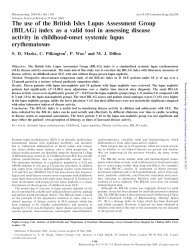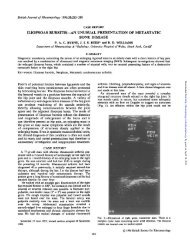Letter to the Editor (Case Report) - Rheumatology
Letter to the Editor (Case Report) - Rheumatology
Letter to the Editor (Case Report) - Rheumatology
Create successful ePaper yourself
Turn your PDF publications into a flip-book with our unique Google optimized e-Paper software.
Rheuma<strong>to</strong>logy Advance Access published February 20, 2009<br />
Rheuma<strong>to</strong>logy 2009; 1 of 2<br />
doi:10.1093/rheuma<strong>to</strong>logy/kep017<br />
<strong>Letter</strong> <strong>to</strong> <strong>the</strong> Edi<strong>to</strong>r (<strong>Case</strong> <strong>Report</strong>)<br />
Non-infectious endocarditis in a patient with<br />
cANCA-associated small vessel vasculitis<br />
SIR, ANCAs are frequently associated with a limited group of<br />
small vessel vasculitic syndromes, referred <strong>to</strong> as ANCA-associated<br />
small vessel vasculitis (ANCA-associated SVV) [1]. ANCAassociated<br />
SVV is <strong>the</strong> most common primary systemic small<br />
vessel vasculitis in adults and includes three categories: WG,<br />
microscopic polyangiitis and Churg–Strauss syndrome [1].<br />
Non-infectious cardiac involvement in ANCA-associated SVV<br />
is more frequent than it is thought [2]. However, both ANCAassociated<br />
SVV with endocardial compromise and subacute<br />
bacterial endocarditis (SBE) have <strong>the</strong> many overlapped clinical<br />
manifestations including detectable vegetations by cardioechography,<br />
inflamma<strong>to</strong>ry signs, renal involvement and constitutional<br />
symp<strong>to</strong>ms. In addition, strep<strong>to</strong>coccal SBE sometimes shows<br />
positive cANCA testing [3]. Here we report a case of noninfectious<br />
endocarditis with ANCA-associated SVV, which could<br />
be diagnosed in early stage by careful clinical observation as well<br />
as labora<strong>to</strong>ry findings.<br />
A 67-year-old woman presented a 1-month his<strong>to</strong>ry of fever,<br />
polymyalgia and anorexia. Two weeks before admission, she<br />
visited <strong>the</strong> former hospital and subsequently received antibiotic<br />
<strong>the</strong>rapies. As her symp<strong>to</strong>ms continued, she was admitted <strong>to</strong> our<br />
hospital. On admission, her temperature was 38.58C. Heart rate<br />
was 80/min and blood pressure was 130/80 mmHg. Lungs were<br />
normal. Auscultation of <strong>the</strong> heart revealed a sys<strong>to</strong>lic murmur over<br />
<strong>the</strong> aortic area. On labora<strong>to</strong>ry data, white blood cell counts were<br />
16 400/mm 3 , with 84% neutrophils. Red blood cell count was<br />
329 10 4 /mm 3 and haemoglobin was 9.5 g/dl. Platelet count was<br />
21.3 10 4 /mm 3 . CRP was 5.2 mg/dl. ESR was 121 mm/h. Blood<br />
cultures were performed four times and were all negative. Plasma<br />
glucose was 103 mg/dl. Electrolytes, proteinogram, renal function<br />
and liver enzymes were all within <strong>the</strong> normal range. Urinalysis<br />
revealed that glucose was 100 mg/dl, proteinuria 30 mg/dl, microhaematuria<br />
3þ [20–29 red blood cells/high-power field (HPF)].<br />
Complements were all within <strong>the</strong> normal range. ANA was negative.<br />
RF was 38.7 IU/ml (
2of2<br />
<strong>Letter</strong> <strong>to</strong> <strong>the</strong> Edi<strong>to</strong>r<br />
Proteinase-3-ANCA (PR3-ANCA) is well known <strong>to</strong> be a<br />
specific marker of WG, which has a sensitivity and specificity of<br />
>90% [7]. Fur<strong>the</strong>rmore, it was less likely <strong>to</strong> detect o<strong>the</strong>r diseases<br />
and <strong>the</strong> results of positive cANCA only in ELISA shows <strong>to</strong><br />
have a specificity of 98% [8]. It is recognized worldwide that<br />
ELISA testing against ANCA is superior <strong>to</strong> <strong>the</strong> IF method in <strong>the</strong><br />
diagnosis of ANCA-associated SVV [8]. On <strong>the</strong> o<strong>the</strong>r hand, it is<br />
well known that a variety of infectious and non-infectious diseases<br />
could sometimes result in false positive ANCA tests by IF,<br />
associated with negative specific ELISA testing for anti-PR3 or<br />
anti-MPO [8]. Moreover, it has been reported that even if used<br />
by ELISA, <strong>the</strong>re are <strong>the</strong> exclusive cases which could not be<br />
diagnosed as ANCA-associated SVV and that cANCA tests by<br />
IF and PR3-ANCA by ELISA are positive in some patients<br />
with SBE [3]. Therefore, it has been emphasized that <strong>the</strong><br />
differences of clinical symp<strong>to</strong>ms are important <strong>to</strong> differentiate<br />
those cases [9].<br />
Cardiac involvement in WG is more common than generally<br />
thought, ranging from 6 <strong>to</strong> 44% of patients [2] and includes<br />
coronary arteritis, pericarditis, myocarditis, valvulitis/endocarditis,<br />
conduction system granulomata, sinus node arteritis, AV node<br />
arteritis, myocardial infarction and epicarditis [10]. In <strong>the</strong> present<br />
case, <strong>the</strong> findings of electrocardiography showed myocardial<br />
injury possibly caused by coronary arteritis, valvulitis or<br />
myocardial infarction, suggesting au<strong>to</strong>immune cardiac involvement<br />
in WG. We assume that <strong>the</strong> au<strong>to</strong>immune myocardial injury<br />
could be improved by steroid <strong>the</strong>rapy, as <strong>the</strong> findings of<br />
electrocardiography were normalized after treatment. ANCAassociated<br />
SVV with endocardial compromise and ANCApositive<br />
SBE have overlapping clinical and labora<strong>to</strong>ry manifestations.<br />
ANCA-associated SVV with endocardial compromise<br />
involved almost exclusively <strong>the</strong> aortic valve and was associated<br />
with skin, renal, respira<strong>to</strong>ry involvement, normal complement<br />
levels and <strong>the</strong> absence of splenomegaly [9]. In particular,<br />
echocardiographic findings had been documented <strong>to</strong> be able <strong>to</strong><br />
detect aortic valve thickening including discrete vegetations and<br />
aortic insufficiency with or without aortic root dilatation. Discrete<br />
large vegetations seen on echocardiography suggest SBE; however,<br />
small discrete vegetations have also been sometimes reported<br />
in ANCA-associated SVV with endocardial compromise [9].<br />
Therefore, <strong>the</strong> echocardiographic findings could not make definite<br />
diagnosis. We diagnosed <strong>the</strong> present case as <strong>the</strong> early stage of<br />
systemic ANCA-associated SVV associated with endocardial<br />
compromise but not SBE even though she had high fever and<br />
her echocardiogram revealed <strong>the</strong> vegetation on <strong>the</strong> aortic valve.<br />
The diagnosis could be reached by detailed observation of her<br />
clinical manifestations as well as positive cANCA testing and<br />
finally proved by pathohis<strong>to</strong>logical findings. Early diagnosis<br />
subsequently could start prompt steroid <strong>the</strong>rapy, leading <strong>to</strong> <strong>the</strong><br />
improvement of clinical and symp<strong>to</strong>matic manifestations as<br />
ANCA-associated SVV responds <strong>to</strong> immunosuppressive <strong>the</strong>rapies,<br />
including <strong>the</strong> usage of steroids, cyclophosphamide or AZA,<br />
but does not respond <strong>to</strong> antibiotic <strong>the</strong>rapies. In contrast, SBE<br />
responds <strong>to</strong> appropriate antibiotic <strong>the</strong>rapies and adding immunosuppressive<br />
<strong>the</strong>rapy is not effective and not recommended.<br />
Therefore, <strong>to</strong> avoid <strong>the</strong> unrequited and no effective treatments, we<br />
emphasize <strong>the</strong> importance for differentiating <strong>the</strong> non-infectious<br />
endocarditis with cANCA-associated SVV from infectious endocarditis<br />
in <strong>the</strong> early stage by careful clinical observations.<br />
Rheuma<strong>to</strong>logy key message<br />
In ANCA-positive patients, it is important <strong>to</strong> differentiate noninfectious<br />
endocarditis from infectious endocarditis.<br />
Disclosure statement: The authors have declared no conflicts of<br />
interest.<br />
TARO HORINO 1 ,TOSHIHIRO TAKAO 2 ,YOSHINORI TANIGUCHI 1 ,<br />
YOSHIO TERADA 1<br />
1 Department of Endocrinology, Metabolism and Nephrology and<br />
2 Division of Community Medicine, Department of Community<br />
Nursing, Kochi Medical School, Kochi, Japan<br />
Accepted 14 January 2009<br />
Correspondence <strong>to</strong>: Taro Horino, Department of<br />
Endocrinology, Metabolism and Nephrology, Kochi Medical<br />
School, Kohasu, Okoh-cho, Nankoku, Kochi 783-8505, Japan.<br />
E-mail: horinott@yahoo.co.jp<br />
1 Jennette JC, Falk RJ. Small-vessel vasculitis. N Engl J Med 1997;337:1512–23.<br />
2 Goodfield NE, Bhandari S, Plant WD, Morley-Davies A, Su<strong>the</strong>rland GR. Cardiac<br />
involvement in Wegener’s granuloma<strong>to</strong>sis. Br Heart J 1995;73:110–5.<br />
3 Choi HK, Lamprecht P, Niles JL, Gross WL, Merkel PA. Subacute bacterial<br />
endocarditis with positive cy<strong>to</strong>plasmic antineutrophil cy<strong>to</strong>plasmic antibodies and antiproteinase<br />
3 antibodies. Arthritis Rheum 2000;43:226–31.<br />
4 Leavitt RY, Fauci AS, Bloch DA et al. The American College of Rheuma<strong>to</strong>logy 1990<br />
criteria for <strong>the</strong> classification of Wegener’s granuloma<strong>to</strong>sis. Arthritis Rheum 1990;<br />
33:1101–7.<br />
5 Hoffman GS, Kerr GS, Leavitt RY et al. Wegener granuloma<strong>to</strong>sis: an analysis of 158<br />
patients. Ann Intern Med 1992;116:488–98.<br />
6 Ponniah I, Shaheen A, Shankar KA, Kumaran MG. Wegener’s granuloma<strong>to</strong>sis: <strong>the</strong><br />
current understanding. Oral Surg Oral Med Oral Pathol Oral Radial Endod 2005;<br />
100:265–70.<br />
7 Merkel PA, Polisson RP, Chang Y, Skates SJ, Niles JL. Prevalence of antineutrophil<br />
cy<strong>to</strong>plasmic antibodies in a large inception cohort of patients with connective tissue<br />
disease. Ann Intern Med 1997;126:866–73.<br />
8 Harris A, Chang G, Vadas M, Gillis D. ELISA is <strong>the</strong> superior method for detecting<br />
antineutrophil cy<strong>to</strong>plasmic antibodies in <strong>the</strong> diagnosis of systemic necrotising<br />
vasculitis. J Clin Pathol 1999;52:670–6.<br />
9 Chirinos JA, Corrales-Medina VF, Garcia S, Lichtstein DM, Bisno AL, Chakko S.<br />
Endocarditis associated with antineutrophil cy<strong>to</strong>plasmic antibodies: a case report and<br />
review of <strong>the</strong> literature. Clin Rheuma<strong>to</strong>l 2007;26:590–5.<br />
10 Fors<strong>to</strong>t JZ, Overlie PA, Neufeld GK, Harmon CE, Fors<strong>to</strong>t SL. Cardiac complications<br />
of Wegener granuloma<strong>to</strong>sis: a case report of complete heart block and review of <strong>the</strong><br />
literature. Semin Arthritis Rheum 1980;10:148–54.<br />
Downloaded from http://rheuma<strong>to</strong>logy.oxfordjournals.org/ by guest on August 30, 2013















